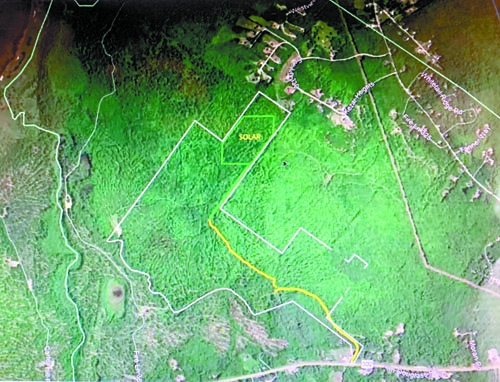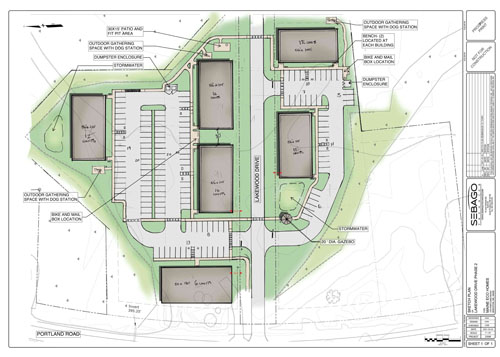Bridgton shows signs of continued growth
By Wayne E. Rivet
Staff Writer
Kurt Boeker worked out of his home’s basement, building a small company that designs and sells non-lethal technology to law enforcement, the military and the general public for self defense. He needed more space. Bridgton caught his eye.
Calvin Gorrell is “passionate” about pizza, and believes he has found the right spot for his wood-fired eatery — the space formerly occupied by Bare Bones Beer.
When Justin McIver started to build apartment complexes off Portland Road, his phone kept ringing off the hook as people inquired about availability. The demand remains very strong, leading McIver to launch Phase 2 of his Lakewood Apartments project.
Deep in the woods off North High Street, a solar farm utilizing about 20 acres is in the planning pipeline.
All four found Bridgton as the ideal target for their projects.
Bridgton is growing, and the town’s Planning Board is seeing it up close.
With a full agenda Tuesday, Board Chairwoman Deb Brusini noted at the start of the virtual meeting that due to the numerous projects slated for review, officials had already penciled in another session for Wednesday, if needed.
Despite lengthy discussions, the board cleared the deck after 3 hours and 45 minutes of presentations, deliberations and decision-making.
After a 4-0 vote on the Finding of Facts and Conclusions of Law, approving the Mountain Road Storage plan, presented by Mark Lopez, the board heard these proposals:

North High Street Solar — Before civil engineer David Albrecht and project developer Ryan Bailey could present the project details, planners decided to hold a public hearing (April 28, 5 p.m.) on the proposal after receiving various comments from abutters.
Planner Dee Miller admittedly had a hard time envisioning where the solar farm would be located, as well as its proximity to residential homes. She requested a site walk be held to give planners a “clearer picture.”
“I’m not really clear where this is. The topographical maps don’t have a lot of land marks or markings to let me know where it is, or its impact on abutters,” she said. “I would like to orient myself to where it is.”
Albrecht explained the property is accessed from Route 302, but a “skid road” would take planners part of the way with the remaining mile requiring hiking in.
“The reason you don’t know where it is, it’s a mile walk deep in the forest,” Albrecht noted.
Bailey concurred, “It’s a mess to get through. It will require a little bushwhack. Access could be gained through a neighbor’s property, but you would need permission.”
Luckily, one neighbor whose property is closest to the proposed solar farm, Jim Curtis, happened to be part of the virtual audience. He welcomed planners to cross his property to get to the site. He inquired why the developer chose that location rather than other available options. Brusini said the question, and others from the public, could be made at the public hearing.
Brusini asked if the site of the solar array could be flagged in some way? Albrecht said flags could be placed along the periphery, but the flags will not be visible from the neighborhood to the north due to the 30 to 50-foot trees. Albrecht said the solar array measures about nine feet in height.
Abutter Kristen Short, whose family owns 178-acres that is in tree growth, also offered planners an access point.
“I’m not interested getting in middle of the site, but I would like to have idea where it is in relation to the abutters,” Miller said.
Planner Dan Harden noted that he recently walked a piece of property he purchased and early spring conditions made hiking “not fun right now.”
Albrecht gave planners a better idea of the site’s location by calling up the parcel on Google Earth. The targeted 20 acres is part of a 300-acre parcel owned by Rex Rolfe Corporation. Kezar Pond is a mile away from the edge of the property.
Resident Ken Ainsley agreed it is difficult to get orientation where the solar farm would be due to dense forest, so he floated the idea about using balloons to mark the area.
Albrecht failed to see how balloons would help since if they were placed at nine feet from the ground — the height of the solar arrays — planners would still be unable to see them from the abutters’ properties due to tree density. If placed above the tree line, it would be difficult and “confusing” to try to envision the arrays, which would be 40 feet below those marks.
How about a drone fly over the area?
Brusini said she needs to be able to visualize what a person sitting in the backyard of their homes are going to see, if anything. “I don’t know if a drone would do that,” she said. Brusini, an experienced hiker, is willing to hike down into the woods and snap photos using her cellphone of the visual line from the array location toward neighbors, and then share those photos with planners.
A site walk, which is open to the public, will be held on Sunday, April 25 at 1 p.m. Brusini added that public comment on the project is being accepted.
Albrecht made a brief presentation about the project. Features include:
• Answering Ainsley’s question, another parcel was considered, but the landowner preferred the chosen piece, which is located in the correct zoning district.
• Two wetland and a potential vernal pool are located there; required buffers were observed in position the road that leads to the site; setback requirements were also observed in siting the solar farm from abutting property lines.
Setback property lines. The gravel service road will be 14 feet wide, and is designed to support the weight of a fire truck. To satisfy Fire Chief Tom Harriman’s concerns about accessibility, the plan calls for places (road widens to 20 feet) where vehicles can pass
• There will be no barbed wire or razor wire used with perimeter fencing.
• The array system does not require concrete pads, instead, it uses four screws into ground upon which racks are installed — small posts in the front, large posts in back; panels don’t move, it is a fixed tilt system, all oriented to the south.
• All utilities underground. Two equipment areas include an inverter at each location; smaller equipment also on site to remotely monitor the facility. None of the equipment is higher than nine feet; thesystem racking is 8.5 to 9 feet tall.
• Trees will be cleared inside the fence, and the area revegetated with seed mix. The area will be mowed two to three times annually.
Items planners would like to see more information include research on botanical features and wintering areas at the site (issues raised by Inland Fisheries and Wildlife), a complete decommissioning plan, bonding (which the town asked for in another solar farm project), stormwater management plan and the “reflective properties” of the array.
Nora Belle Pizza
Calvin Gorrell has put plenty of thought on what it will take to operate a successful wood-fired craft pizzeria.
He tested ideas in the field last spring and summer by operating a mobile pop-up pizzeria. “It provided an opportunity for research and development, while getting market feedback,” he wrote in his Bridgton application.
As an executive chef, Gorrell has been working toward opening his own pizzeria since 2017. He likes the idea of placing the eatery at the former Bear Bones Beer location on Cottage Street, next door to the Bavarian Chocolate Haus.
The space will require some renovation with the installation of a wood-fired oven (thus need for a chimney), along with a service counter and bar (beer and wine will be served).
Gorrell plans an “open kitchen concept,” where customers can watch food preparation while seated at a 13-foot counter. Seating capacity is 29, and Nora Belle’s would be open Tuesday through Sunday, 11 a.m. to 10 p.m. Gorrell will start with a “small menu” geared toward take-out and work toward a full-service model, when it becomes feasible. The site has 13 public parking spaces, with additional parking available in a municipal lot across Main Street. Brusini suggested Gorrell check in with library officials about possible use of the lot during evening hours when the library is closed. Gorrell plans to introduce himself to all neighbors to “put a face to the name of the business.”
“I want to see how we’re received by community, what the community wants,” he told planners. “Pizza is humble and very approachable.”
There is no plans for entertainment. “I want to be good neighbor and good tenant,” he added.
Gorrell noted Nora Belle’s — which is named after his daughter — is a“family-run” business, with family and friends pitching in to get the new venture off the ground.
“I am here for the love of the game and love of pizza,” he said.
Planners gave tentative approval, looking for a statement regarding trash disposal. The board will do their Findings of Fact and Conclusions of Law at their next meeting.
Grimburg Less Lethal
Before Kurt Boeker could give a rundown on his proposal to use the former church and daycare center at 1320 North High Street as the new location for Grimburg Less Lethal, he barely avoided seeing the presentation moved to another night due to not showing a signed lease agreement for the property.
Boeker indicated he has a five-year lease, and luckily the property’s owner was in the virtual audience to verify the statement. A copy of the agreement would be filed with the town immediately.
Cleared to move forward, Boeker explained Grimburg’s initial start-up was funded through a grant from Maine Institute of Technology. The technology is equipping paintball guns to fire rubber bullets. Police use this technology during riots and other circumstances requiring a “less lethal” response. The “projectiles” — used in air-powered guns, not firearms — are manufactured in Biddeford and southern New Hampshire. Products would be upgraded, assembled and shipped from the Bridgton location.
Boeker said the Bridgton site would also be used for design work using a 3D printer, as well as product testing. It is a small operation with Boeker and a couple of high school students who assist with assembly and packing.
“There will be no stray shots going over Route 302 or a neighbor’s house. If I shot my own window, the projectile drops a few feet,” Boeker said.In regards to noise, Boeker said, “water trucks going by are louder what you hear from us. When we build a gun, we fire it 4 or 5 times to test it before we put it in a box. It’s not a big disturbance; we wear ear protection but it’s quieter than a nail gun.”
Looking to keep the operation low key, an exterior sign would carry the company name and logo. Boeker does not plan to use the location as a retail spot.
Tentative approval was given (statement about the exterior sign and lighting, along with addressing the fire chief’s recommendations, and a copy of the lease).
“I’ve always loved Bridgton and happy to be moving our business here,” Boeker said.

Lakewood Apartments, Phase 2
Because the application was deemed incomplete by planners (3-2 vote, Dan Harden and Mike Figoli in the minority), Main Eco Home’s Justin McIver apologized to the board for failing to provide all necessary information and willing pushed discussion of his proposed Lakewood Estates at Mt. Henry subdivision proposal until the next scheduled board meeting.
But, McIver and Craig Burgess of Sebago Technics of South Portland moved ahead with a pre-application conference with the board regarding Phase 2 of the Lakewood Apartments project.
Due to “great demand” and “success” in renting all of the apartment units created in Phase 1, McIver sees a continued need for apartments and decided to expand the project to the “front end of the property.” That expansion calls for three buildings — two containing 16 units and the other a 12-unit structure — to the left side of the Lakewood Drive road two apartment complexes — 12 units each — to the right of the roadway. A commercial building would be sited closest to Portland Road, to the left.
McIver said the new development would carry a different color scheme that the Phase 1 buildings but “aesthetics would remain consistent.” Sidewalks and a gazebo are also part of the plan. The project would be on town water and hook into the expanded wastewater system Bridgton is constructing.
McIver noted he would also like to develop a sidewalk along Route 302, a topic he has raised with the Select Board in an attempt to develop safer, improved walkability from Main Street out to Portland Road. Since the town will be doing construction work on Route 302 for the wastewater system, it would be a good time to broach the subject with Maine DOT, McIver added.
“I’d love to see it (sidewalk) connected to downtown. A number of tenants walk into town. I definitely needs to be looked at closer,” McIver said.“I want to create something special here. I definitely am planning on some robust landscaping to create a pleasing visual from 302.”
McIver said he is open to ideas planners might have after studying the plan.
Planner Dee Miller asked if McIver has had any discussions with school officials regarding the possible effects of developing residential housing upon the educational system. McIver said he “would love to sit down with them.” He noted that of the 60 people living in his existing Lakewood Apartments, there are only two children — likely the result of most units having one or two bedrooms. McIver is considering developing housing units with three bedrooms.
Return to In-Person
At the close of Tuesday’s session, planners discussed returning meetings to in-person. The first one will be on April 20, with some restrictions. Board members will be socially distanced and masks will be required of all in attendance. Just 14 members of the public will be allowed in the meeting room.
Meetings will continued to be aired via Zoom.

